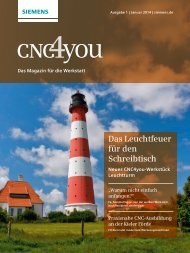spectrum
spectrum
spectrum
Create successful ePaper yourself
Turn your PDF publications into a flip-book with our unique Google optimized e-Paper software.
Servo-presses<br />
10 <strong>spectrum</strong> METAL FORMING 2012<br />
p Lasco Umformtechnik GmbH, Germany<br />
Servo-electric<br />
Hydraulic Pumps<br />
The press manufacturer Lasco uses an electric servo-pump<br />
control for mass forming and the optimization of large<br />
hydraulic presses, thus achieving energy savings as well as<br />
improved p dynamics. y<br />
Lasco Umformtechnik GmbH, a prestigious<br />
manufacturer of mass forming and sheet<br />
presswork equipment based in Germany, is<br />
always focused on improving its processes and technologies.<br />
One such technological milestone is the<br />
servo technology used in a recently delivered deep<br />
drawing press with a force of 800 tons for up to<br />
40 strokes per minute. This offers huge benefits<br />
» Among other things, our new<br />
servo technology enables<br />
operators to achieve<br />
appreciable energy savings. «<br />
Harald Barnickel, Head of Electrical Engineering Department,<br />
Lasco Umformtechnik GmbH<br />
from a technical point of view and also in terms<br />
of energy consumption. “Among other things, our<br />
new servo technology enables operators to achieve<br />
appreciable energy savings,” reports Harald Barnickel,<br />
head of Lasco’s electrical engineering<br />
department.<br />
Servo technology delivers<br />
outstanding results<br />
Servomotors that are flange-mounted directly onto<br />
the hydraulic pump form the heart of the solution.<br />
The power control of the drive is controlled by a<br />
Sinamics S120 frequency converter, while the<br />
Simotion D445 controller is responsible for the<br />
overall control of the axis path, speed, and position.<br />
“Initial operating data have indicated that this servo<br />
technology delivers outstanding results in many<br />
respects – with regard to both energy consumption<br />
and technology,” confirms the electrical engineer.<br />
The deep drawing press is to be used to manufacture<br />
seat rails for motor vehicles in six consecutive stations.<br />
For this, pressing force and stroke speed<br />
needed to be adapted to an individual movement<br />
profile. The pressing force can be adjusted at the servomotor<br />
by means of the torque. The plunger speed,<br />
however, is controlled via the motor speed and<br />
therefore via the flow rate of the pump. Thanks to<br />
this technique, valve technology savings of up to<br />
40 percent are possible in the press.<br />
Energy savings and system continuity<br />
The use of servo technology also results in a significant<br />
improvement in the energy balance. “It was previously<br />
necessary to use large cooling systems for<br />
the oil, but much smaller units can be used with the<br />
servo technology,” says Barnickel. The associated<br />
improvement in efficiency, which the press manufacturer<br />
considers to be well into double figures, is<br />
reflected by massive savings in electricity costs compared<br />
to the older machines. An added advantage is<br />
that energy can be recovered during decompression<br />
of the hydraulic fluid. “The opposite would be true of<br />
other concepts, where there would even be additional<br />
heat losses,” explains Barnickel.<br />
According to Barnickel, an additional plus point is<br />
the system consistency offered by the Siemens solutions.<br />
For example, the Simotics M-1PH8 servomotor,<br />
available as a synchronous or asynchronous<br />
motor, is automatically identified by the frequency



